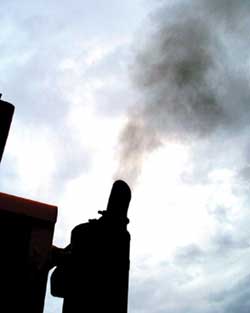Summary Statement
Practical advice on how to reduce exposure to diesel emissions in construction, including information on sources and components of exhaust, health effects and control measures.
Winter 2002/2003
Recently the Environmental Protection Agency in the U.S. released a health-impact report on diesel exhaust. Although the long-term health effects of diesel exhaust are uncertain, studies strongly suggest a cancer risk to humans.
This article provides practical advice on how to reduce exposure to diesel emissions in construction.
Where are construction workers likely to be exposed to diesel exhaust?
Personnel can be exposed to diesel exhaust almost anywhere as they operate or work around equipment such as
- generators
- rough-terrain forklifts
- compressors
- concrete trucks
- packers
- bobcats
- cranes
- front-end loaders
- powered elevating work platforms
- welding machines.
What are the components of diesel exhaust?
Also known as diesel fumes, diesel exhaust is a complex mixture of gases and diesel particulate matter (DPM). Components include
- carbon monoxide
- carbon dioxide
- sulphur dioxide
- nitrogen oxides
- aldehydes including benzene and formaldehyde
- hydrocarbons
- polycyclic aromatic hydrocarbons (PAHs)
- soot (carbon).
The major component of diesel exhaust is soot (60%-80%). This is what you see coming out of the exhaust pipe.
Most of the DPM, also known as fine particulate matter, consists of particles so tiny they are easily inhaled and deposited in the lower lungs where they cause various health effects.
What are the health effects of exposure?
In the short term, breathing in diesel fumes can cause coughing, itchy or burning eyes, chest constriction, wheezing, and difficulty breathing. These effects disappear when the worker is away from the source of the fumes.
Over the long term (20 years or so), exposure to diesel fumes may increase the risk of lung cancer and possibly bladder cancer. There is additional evidence that the fine particles in DPM can aggravate heart problems and respiratory illnesses such as asthma.
How can exposure be controlled?
Although every construction site is unique, some common actions can be taken to reduce exposure to diesel exhaust.
1. Use low-sulphur diesel fuel (less than 0.05% sulphur). This reduces
- sulphur emissions and assciated odours
- engine wear maintenance costs.
2. Retrofit engines with an exhaust filtration device to capture DPM before it enters the workplace. The most common exhaust filtration devices are
- disposable diesel exhaust paper filters
- diesel particulate ceramic filters.
3. Locate the exhaust pipe so that diesel fumes are directed away from the operator and nearby workers. This simple measure can make a big difference in the fume concentration to which personnel are exposed.
4. Use a catalytic converter to reduce carbon monoxide, aldehydes, and hydrocarbons in diesel fumes. These devices must be used with low sulphur fuels. Using converters with high-sulphur diesel fuels may do more harm than good to air quality.
5. Ventilate wherever diesel equipment operates indoors. Roof vents, open doors and windows, roof fans, or other mechanical systems can be used to move fresh air through work areas. As buildings under construction are gradually enclosed, remember that fumes from diesel equipment operating indoors can build up to dangerous levels without adequate ventilation.

6. Attach a hose to the tailpipe of a diesel vehicle running indoors and exhaust the fumes outside where they can’t reenter the workplace. Because exhaust hoses tend to be treated roughly, inspect them regularly for defects and damage.
7. Use enclosed, climate-controlled cabs pressurized and equipped with high efficiency particulate air (HEPA) filters to reduce operators’ exposure to diesel fumes. Pressurization ensures that air moves from inside to outside. HEPA filters ensure that any air coming in is filtered first.
8. Regular maintenance of diesel engines is essential to keep exhaust emissions down. Follow the manufacturer’s recommended maintenance schedule and procedures. Smoke colour can signal the need for maintenance. For example, blue/black smoke indicates that an engine requires servicing or tuning.
9. Work practices and training can help reduce exposure. Here are just two examples.
- Turn off engines when vehicles are stopped for more than a few minutes. Idling wastes fuel and increases diesel emissions.
- Train diesel-equipment operators to perform routine inspection and maintenance. For instance, operators should know when to change exhaust filtration devices.
10. When purchasing a new vehicle, ensure that it’s equipped with the most advanced emission control systems available.
11. With older vehicles, use electric starting aids such as block heaters to warm the engine, avoid difficulty starting, and thereby reduce diesel emissions.
12. Respirators are only an interim measure to control exposure to diesel emissions. In most cases an N95 respirator is adequate. Note the following points about respirator use.
- Respirators are for interim use only, until primary controls such as ventilation can be implemented.
- Workers must be trained and fit-tested before they wear respirators. A competent person familiar with the selection, care, and use of respirators must perform the fit testing.
- Respirators must bear a National Institute of Occupational Safety and Health (NIOSH) approval number. Never use paper masks or surgical masks without NIOSH approval numbers.
- Workers must be clean-shaven when wearing respirators. Beards, even stubble, will allow some fumes to bypass the respirator and be inhaled.
 |
 |
| For respirators to make an effective seal, wearers must be clean-shaven. | |



